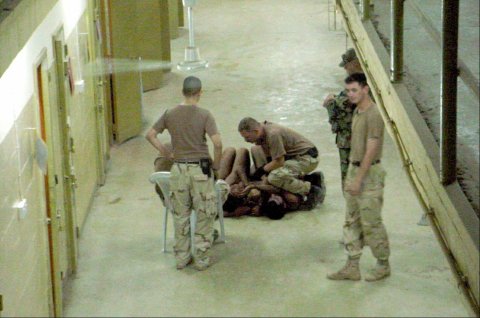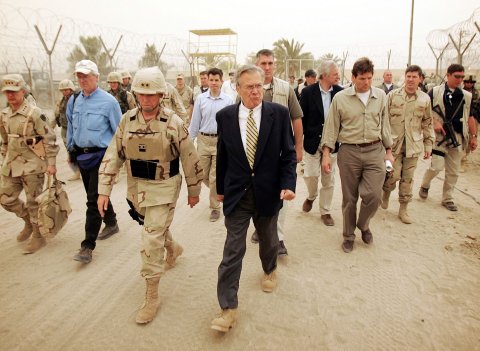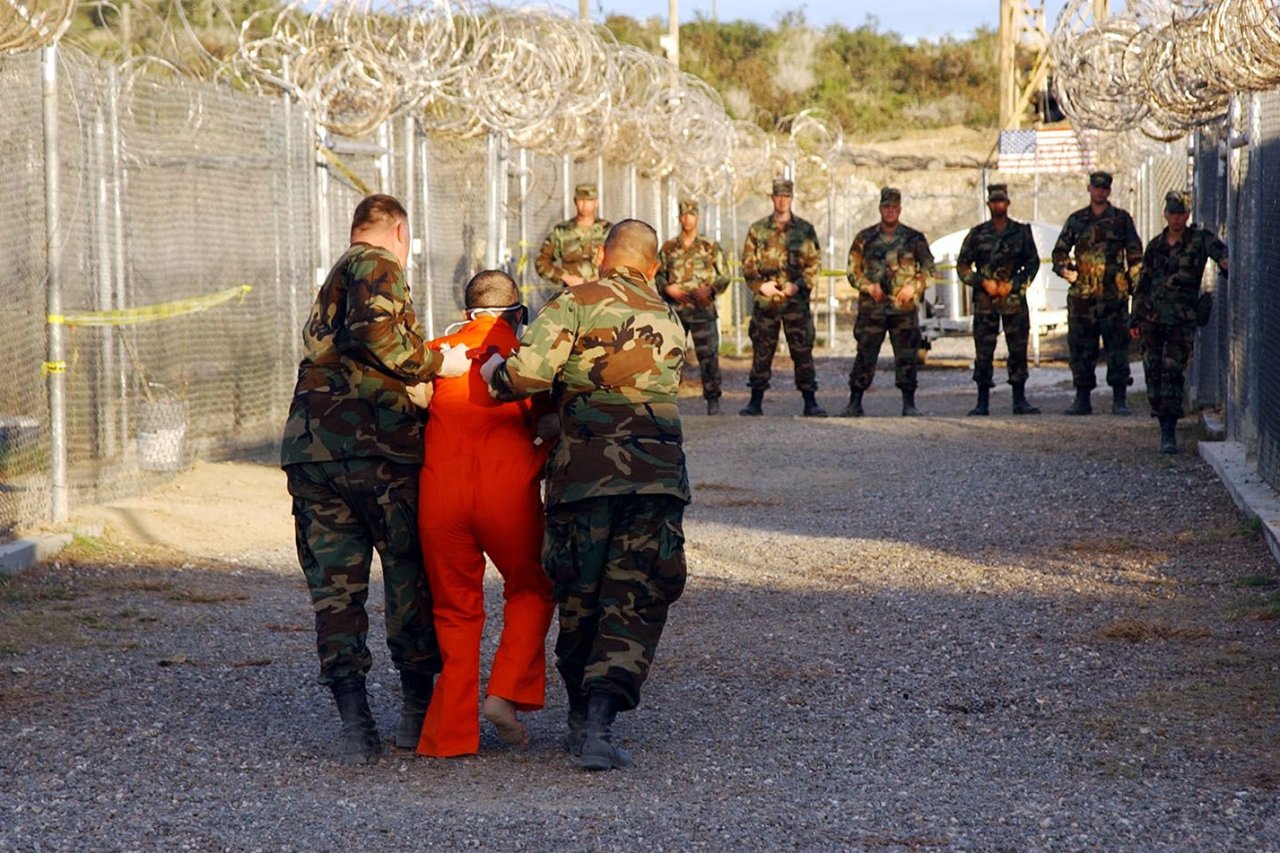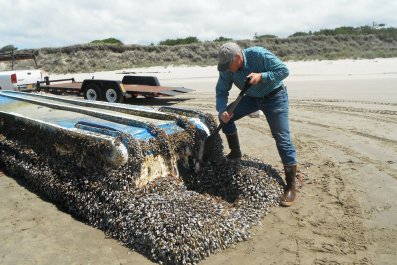"What the fuck? Who are these guys?"
It was February 2002, and I was giving Bob McFadden a tour of Camp X-Ray, a crude detention center on the far corner of the U.S. prison in Guantánamo Bay, Cuba. As the deputy commander of the Defense Department's Criminal Investigation Task Force at Gitmo, I oversaw the investigation and interrogation of suspected militants. The goal: to probe their networks and bring them to trial. As I explained to McFadden, a former colleague at the Naval Criminal Investigative Service, the job was, well, complicated.
Nearly all the detainees at Gitmo had been nabbed in Afghanistan. We housed them in outdoor mesh cages made of fencing material. Each cage had two buckets, one for drinking water, the other for human waste. It was sort of like a high-security, low-rent zoo.
By the time McFadden arrived, the camp was getting overcrowded. We asked for better facilities but were told to "hang tight" because Gitmo was just a temporary holding site. In the meantime, I showed my old friend around, warning him about the camp's more eccentric characters. One guy, whom we nicknamed Wild Bill, would chuck his shit at you if you got too close. Another, Waffle Butt, would press his bare ass against the mesh any time someone got near him.
None of that bothered McFadden. He'd been inside plenty of nasty places. But as soon as the detainees realized he spoke Arabic, they began yelling at him: "Please, please, mister, mister! There's been a mistake! There was a mix-up." McFadden talked to some of them, and I could see his face getting more and more troubled. Finally, he grabbed a list of detainees, scanned the names, looked at the mass of prisoners in front of him and shouted out, "None of them are Arabs!" The detainee list was full of Afghan and Pakistani names such as Iqbal and Khan. Whoever they were, they weren't part of the core Al-Qaeda network—the Egyptians, Saudis and other Arabs whom U.S. intelligence been tracking for years.
In the fall of 2001, the primary justification for invading Afghanistan was to capture Osama bin Laden and his inner circle. That hadn't happened, but our military hadn't given up on the chase. Helicopters were still dropping flyers offering $5,000 bounties for Taliban or Al-Qaeda members. Most of the Afghan and Pakistani groups hunting down militants were just after the reward; they didn't care if they nabbed an innocent man.
The vetting process for determining who might be a militant was equally dysfunctional. Some militants had used a popular model of a Casio digital watch as a timer for bombs; wearing one eventually became suspect, and detainees were actually held at Gitmo because they had been wearing a Casio watch.
When I was setting up the task force, I was promised I'd be dealing with "the worst of the worst" of Al-Qaeda militants. But it soon became clear that McFadden was right—we didn't have them. This was not the job I had signed up for. And soon it would require me to do things against my values, and against the values of America.
'I'd Bring Back Waterboarding'
More than a decade after I showed McFadden around Gitmo, I watched with horror as the Republican candidates for president debated one another in Manchester, New Hampshire. It was February 6, 2016, and they were discussing waterboarding—a now-banned procedure that involves simulating drowning. Jeb Bush was against it, and Ted Cruz danced around the issue. But Donald Trump took a firm stance. Dressed in a baggy blue suit with an American flag pin on his lapel, Trump praised harsh interrogation techniques. "In the Middle East," he said, "we have people chopping the heads off Christians. I would bring back waterboarding, and I would bring back a hell of a lot worse." People in the crowd applauded.
Trump, of course, went on to win the election and move into the White House. And despite the objections from senators such as John McCain, a former torture victim and prisoner of war, he's continued to praise waterboarding as an effective and necessary interrogation tool. He's also talked of reopening secret CIA prisons and expanding Gitmo, where detainees remain forever prisoners in an interminable war.
I don't know if Trump will ever do such things, but if he does, he will be playing right into Al-Qaeda's strategy. When bin Laden and his violent jihadi followers attacked the World Trade Center and the Pentagon on September 11, 2001, they wanted to terrify Americans, to convince them to throw away their ideas of democracy, equality and the rule of law. Facing a shadowy enemy and a new type of warfare—one that occupies a psychological, not just physical, terrain—we did just that. We allowed the enemy to change who we were.
It's a change I know about firsthand. During my time at Gitmo, I watched the amateurish architects of America's torture program develop bogus, brutal interrogation techniques—ones they borrowed from the Chinese Communists. Not only did they fail to get detainees to talk; they also treated them as subhuman—all under Washington's watchful eye, and with its tacit—and sometimes explicit—encouragement.
Most Americans know about the CIA's enhanced interrogation program: how the agency waterboarded suspects and subjected them to other brutal and ineffective interrogation techniques, from slapping to sleep deprivation. What fewer people realize is that the U.S. military did much of the same, creating a battle lab at Gitmo to test out these harsh measures, then employed them in Iraq in prisons such as Abu Ghraib.

I tried to stop this abuse. Others did too. Unfortunately, we failed. It's a failure I fear we'll someday repeat again.
The 20th Hijacker
During my first months at Camp X-Ray, we had bribed the Navy's construction crew with two cases of beer to get them to build us interrogation rooms. They were basically four-sided plywood boxes with doors and a few chairs inside. There was no privacy, making the camp a horrible place for interrogations.
Some of the detainees didn't talk; we called them "head hangers." Even though we knew they weren't going to say anything, we couldn't let it be known that anyone could skip out on interrogations by not talking. So we'd just sit in the room for three hours with the head hangers, asking them a question every 30 minutes or so.
The Saudis were the most dedicated head hangers, but one Saudi national who arrived in mid-February was different. Mohammed al-Qahtani claimed he was a falconry enthusiast who had simply been in Afghanistan when the war began. It was probably a cover story, so we let him talk and talk until we had enough little bits and pieces of his story to build a mosaic. As our task force and the FBI looked into him more closely, and using those tiny clues, we realized he was one of our most valuable detainees.
We knew 19 men carried out the 9/11 attacks, but a growing body of evidence suggested there were supposed to be 20. On three of the four hijacked flights, four "musclemen" controlled the crew and one pilot. The fourth plane only had three; on that flight, the passengers fought back and the plane crashed in Shanksville, Pennsylvania. Al-Qahtani, we surmised, using Immigration and Naturalization Service flight data and other sources, was supposed to be the 20th hijacker.

At the time, there was a lot of pressure to produce intel. Everybody wanted to know where bin Laden was hiding and how to prevent more attacks. Al-Qahtani, we realized, could have valuable information. Unfortunately, for him and for us, he had attracted the manic attention of Major General Michael Dunlavey.
In February, not long after McFadden arrived, the Army started a new joint task force to take over intel gathering. The way I understood it, my team would continue to do criminal investigations, and we'd help them. Donald Rumsfeld, the secretary of defense, had picked Dunlavey to run this new intel team at Gitmo. (Neither responded to requests for comment in time for publication.) The choice was an odd one. Dunlavey was a reservist who had done his drilling in signals intelligence at the National Security Agency, which meant his training had very little to do with the human intelligence collection we were doing at Gitmo.
The first signs of trouble surfaced only a week after Dunlavey arrived on the base. The general introduced himself to one of my colleagues by pointing to the two stars on his collar this way: "I'm here now, and I'm in charge!" Later, as I was having drinks with a few colleagues at the Gitmo tiki bar, enjoying the stunning view of the bay, Dunlavey pulled up with his car windows down, blaring "I'm So Excited" by the Pointer Sisters.
Dunlavey's actions might have just seemed silly, but he was the commanding general at a military facility during an unpredictable global war. When people on the base started calling him Cocoa Puffs—after the cereal's ad line: "I'm cuckoo for Cocoa Puffs"—I could tell that discipline was at risk of breaking down.
My main concern with Dunlavey, however, was how he handled interrogations. My team was packed with experts who had been doing interrogation for a living. We all agreed some of the best ways to conduct interrogations involved surprising a detainee with kindness, developing a rapport with him or convincing the prisoner you knew more about his life than you really did. Despite what you might see on television or in the movies, torture often leads detainees to give you unreliable information. They'll say anything to make the pain and discomfort stop.
But Dunlavey's team used very junior staff, usually reservists in their early 20s—and they hadn't been properly trained. Most had never been in an interrogation room with a bad guy before. The reservists had been trained in the techniques described in the Army Field Manual. The program wasn't grounded in science and was mostly ineffective. Even worse, the techniques weren't designed to deal with someone from a non-Western culture. While my team members would sit on the floor and drink tea and talk to detainees about soccer to gain their confidence, Dunlavey's interrogators would walk into a room with a shopping list of intelligence requirements. Some did so with an almost comical self-confidence. One guy even wore a cowboy outfit into a session, including a vest and chaps.
They had the swagger, but Dunlavey's team members failed miserably once they tried to stare down a detainee. They just read generic questions off a list, and the interrogations went nowhere. Eventually, a detainee would put his head down and stop talking.
Unfortunately, Dunlavey had a very handy excuse for his group's failures. In 2000, British authorities had found a computer file during a raid on the house of a suspected militant in Manchester, England. On the file was a manual—later known as the Manchester Document—that laid out how Al-Qaeda militants should wage war. Among the tactics discussed: details on what treatment to expect if captured—and advice on resisting and lying to captors. When detainees at Gitmo refused to cooperate, Dunlavey's interrogators were quick to blame "classic Manchester resistance tactics!"
We had no proof that detainees were actually trained in such techniques. But these reputed tactics inspired psychologists James Mitchell and Bruce Jessen, two CIA contractors, who consulted on the agency's "enhanced interrogation techniques." (Jessen did not respond to a request for comment; Mitchell says the CIA's techniques were effective though I strongly disagree).
At Gitmo, Dunlavey's team was drawing a similar conclusion as the CIA contractors: That America needed to get tougher.
Broken Soldiers and False Confessions
As we continued interrogating al-Qahtani, Dunlavey noticed our task force had its own psychologists watching our interrogations and consulting on how we could make the sessions better. He decided his group needed the same type of expertise.
But instead of asking for our help, in early June 2002, he sought assistance from psychologists who had no expertise in real-world interrogations. But like Mitchell and Jessen, they had experience with a U.S. military program called SERE (Survival, Evasion, Rescue and Escape). The program's goal was to teach service members how to deal with being tortured. It was modeled on how the Chinese Communists interrogated Americans during the Korean War (many had elicited false confessions).
The general's team was planning to interrogate al-Qahtani, using techniques that looked suspiciously like Mitchell and Jessen's. And I hurried to stop them.

Because my team had identified al-Qahtani as a potentially high-value target—an actual worst of the worst—I was able to convince the Pentagon to create a pecking order for interrogating suspects. We put the FBI at the top of it; I knew <s>xxx* from a previous investigation and thought he was the best possible person to take on the 20th hijacker. <s>xxx had an amazing knack for developing rapport with subjects. He would sit on the floor with them and discuss politics or religion in his fluent Arabic. In the spring of 2002, <s>xxx had used his rapport-based techniques while interrogating a high-profile detainee <s>xxxxxxxxxxx named Abu Zubaydah, who gave up several important pieces of intel, including naming Khalid Sheikh Mohammed as the 9/11 mastermind and disclosing information about dirty bomber Jose Padilla.
In July 2002, <s>xxx and other FBI agents arrived at Gitmo, hoping to match their progress <s>xxxxxxxxxxx. Initially, they made some moderate progress with al-Qahtani, gathering some intel as well as evidence. Eventually, however, al-Qahtani stopped talking.
The general believed getting tougher was the best way to get intel on Al-Qaeda, prevent attacks and save lives. And though I didn't know it at the time, the U.S. was prepared to change the way we interrogated suspects—and the law governing it. On August 1, 2002, President George W. Bush's White House counsel, Alberto Gonzales, received a 50-page memo from Deputy Assistant Attorney General John Yoo. The document was supposed to define what constitutes torture. Acts that were intended to "inflict severe pain or suffering" were illegal, the memo claimed, but they must be of an "extreme nature" to qualify as torture. "Certain acts may be cruel, inhuman and degrading," the memo said, but are not torture.
So what is torture? The memo set a pretty high bar, one that I think is absurd. It included the case of a man who was pistol-whipped into submission, forced to play Russian roulette, left in a rodent- and scorpion-infested cell, randomly beaten and subjected to some unexplained surgical procedure. Other cases that were considered torture included a nun who was blindfolded, burned with cigarettes and raped, along with a man who was doused in gasoline and burned to death.
Top lawyers at the CIA and Pentagon eventually received the memo. But because I hadn't known about it, I thought that my adversaries were just poorly informed, that they didn't understand that coercive techniques didn't work—and why—or how rapport-based interrogation had a proven history.
I didn't realize I was fighting the White House.
'America's Battle Lab'
In August 2002, with support from the Bush administration, Dunlavey soon got his way. He took over the entire Gitmo operation, and life soon became much harder for detainees. The prison was never a summer camp, but inmates had access to books, including Korans, and food that was appropriate for religious Muslims. Once Dunlavey officially took control, all that ended.
The general wanted to turn Gitmo into what would later be called "America's Battle Lab." The psychologists and psychiatrists on Dunlavey's team would soon be trying out brutal, unproven techniques on the detainees. And al-Qahtani was going to be the group's first guinea pig.
I was more frustrated than ever. Al-Qahtani was likely the 20th hijacker. I didn't like him, but I wanted to interrogate him the right way, effectively and humanely. I did my best to stop Dunlavey. I spoke to my superiors and to legal advisers at the Defense Department and the Navy. None disagreed with me, but they were stymied or ignored by higher-ups at the Pentagon.
Dunlavey's team and interrogators from the Defense Intelligence Agency seized al-Qahtani from his cell and brought him to a new one. They kept him there for days, blinding him with bright lights and blaring music hours a day. Among the songs they played on repeat to keep him awake was Christina Aguilera's "Dirrty." Periodically, they also used large dogs to frighten him.
The techniques didn't work. Al-Qahtani had originally been talkative. Toward the end of the FBI investigation, he began clamming up. But once the enhanced techniques began, he shut down completely.
Dunlavey's team didn't give up on trying to get him to talk. On October 11, 2002, they requested the Defense Department to authorize the approval of even rougher interrogation tactics, including waterboarding and sleep deprivation. But when Dunlavey's request made it up to the Joint Chiefs of Staff, the group's chairman, General Richard Myers, rejected it. The draft memos from the Joint Chiefs staff stated, "We do not believe the proposed plan to be legally sufficient."
Dunlavey had lost. But supporters of harsh interrogation had not been defeated.
Stripped and Forcibly Groomed
Shortly after his request was rejected, the Defense Department replaced Dunlavey with General Geoffrey Miller, an artillery officer with no background in intel.
First impressions don't always mean much, but from the beginning, it was clear that Miller was a hard-ass. He had extremely rigid posture and often ended his sentences with "hoo-ah." The more I listened to him, the more I worried he was going to be just like Dunlavey—only more competent. (Newsweek was unable to reach Miller for comment in time for publication.)
I was right. Miller wanted to immediately authorize a list of new harsh interrogation tactics. "We've got to show [detainees] that we have more teeth than they have ass, hoo-ah!" he would often say.
Not long after Miller took over, I realized that powerful people were behind the push toward detainee abuse. I began emailing key documents to trusted friends and told them to save them. I knew that if things went sideways, I could be relieved of my command and denied access to my office and emails. I needed to stash documentary evidence of everyone's actions at Gitmo at safe locations. I also told our legal counsel to take notes and document every encounter he had with the Defense Department's Office of General Counsel.
Later that month, al-Qahtani's fate was sealed. Rumsfeld signed the request that Dunlavey had initiated, authorizing most of the new list of techniques (he did not authorize waterboarding, for example).
My team had been cut out of any decision-making, but we still had access to an electronic interrogation log recording al-Qahtani's treatment. At the earlier meetings, <s>xxxxxxxxxxx. So I had our analyst send the log book entries up to me every day. Miller's team had no idea we had access to them.
<s>xxxxxxxxxxxxxxxxxxxxxxxxxxxxxxxxxxxxxxxxxxxxxxxxxxxxxxxxxxx
<s>xxxxxxxxxxxxxxxxxxxxxxxxxxxxxxxxxxxxxxxxxxxxxxxxxxxxxxxxxxx
<s>xxxxxxxxxxxxxxxxxxxxxxxxxxxxxxxxxxxxxxxxxxxx.
Al-Qahtani's interrogators knew he would have such an extreme reaction. Many of the detainees were brought up in a culture where women dressed very modestly. In some cases, they may have grown up never seeing a woman in public without her whole body covered. Open sexuality or nudity were shocking taboos. For Americans and Europeans, the nature of this taboo might be imaginable only if they inserted their siblings or cousins in the role of female interrogators and imagined them stripping and rubbing up against them.
<s>xxxxxxxxxxxxxxxxxxxxxxxxxxxxxxxxxxxxxxxxxxxxxxxxxxxxxxxxxxxxx
<s>xxxxxxxxxxxxxxxxxxxxxxxxxxxxxxxxxxxxxxxxxxxxxxxxxxxxxxxxxxxxx
<s>xxxxxxxxxxxxxxxxxxxxxxxxxxxxxxxxxxxxxxxxxxxxxxxxxxxxxxxxxxx.
Medical professionals were direct participants in this treatment. Begrudgingly at times, they had helped develop, recommend and implement practices that were cruel, inhumane and degrading. They were there when the interrogators stripped al-Qahtani, forcibly groomed him and made him wear a leash or act like a dog.
Day after day, however, it had become clear that these techniques were not working. Al-Qahtani was no more forthcoming with useful intel. Rather than turn him into a babbling chatterbox of Al-Qaeda secrets, the harsh approaches served only to harden his resistance.
<s>xxxxxxxxxxxxxxxxxxxxxxxxxxxxxxxxxxxxxxxxxxxxxxxxxxxxxxxxxxxxx
<s>xxxxxxxxxxxxxxxxxxxxxxxxxxxxxxxxxxxxxxxxxxxxxxxxxxxxxxxxxxxxx
<s>xxxxxxxxxxxxxxxxxxxxxxxxxxxxxxxxxxxxxxxxxxxxxxxxxxxxxxxxxxxxx
<s>xxxxxxxxxxxxxxxxxxxxxxxxxxxxxxxxxxxxxxxxxxxxxxxxxxxxxxxxxxxxx
<s>xxxxxxxxxxxxxxxxxxxxxxxxxxxxxxxxxxxxxx.
Meanwhile, the brutal techniques Miller's team was using had begun to spread. In October, military personnel from Afghanistan's Special Mission Units visited Gitmo and learned what was going on at the battle lab. They decided to adopt some of the techniques, from degrading strip searches to using dogs to frighten detainees.
Doing so, advocates claimed, posed little risk, yet some detainees died in Afghanistan as a result of harsh interrogation measures. In late November 2002, an Afghan named Gul Rahman died of exposure while in CIA custody after being left chained to a wall in nearly freezing temperatures overnight. A few weeks later, a 22-year-old taxi driver, known only by the name Dilawar, and the brother of a Taliban leader, Mullah Habibullah, were killed in the custody of their military captors. Both had severe blunt-force trauma on the back of their legs from repeated blows from U.S. soldiers while in custody.
Harsh interrogation and abuse were becoming institutionalized. And soon they would spread to a new country: Iraq.
The Country Club
In the late spring of 2003, officials in Washington were worried. The White House had gone to war fearing Iraq's Saddam Hussein had weapons of mass destruction. But now the U.S. couldn't find them. The timing was perfect for pitching harsh interrogation techniques. If only we got tougher, the thinking went, we could find those WMDs. Some U.S. military personnel were doing just that; they had picked up the techniques at the military base in Bagram, Afghanistan, or at Gitmo.
But the brutality increased after Miller visited Iraq in August 2003 on a mission to "improve" interrogation practices. The men and women interrogating detainees were "running a country club," he reportedly said. They were treating their prisoners too leniently. Miller felt the U.S. needed to employ harsher measures—including shackling and sleep deprivation—to break the Iraqis and get them to talk.
During this visit, the general quickly began pushing for these hard measures. Among his first stops: the prison at Abu Ghraib. Saddam had once housed—and tortured—many of his political enemies there. Now the U.S. was about to carry out brutal and degrading interrogations in the same facility. "You're too nice," Miller reportedly told Army Brigadier General Janis Karpinski, a military police officer who oversaw the detention operations at the prison. "You have to treat them like dogs." (Miller has denied her account of their conversation.)

Following his visit, Miller sent six people from Gitmo to Abu Ghraib to assist in implementing the new interrogation techniques. On September 14, 2003, just a week after Miller left Iraq, Lieutenant General Ricardo Sanchez issued a new policy at the prison and elsewhere. It drew heavily on what Rumsfeld had green-lighted for Gitmo. By October 25, the Defense Department had expanded the interrogation repertoire to include the use of controlled fear, environmental manipulation and isolation, among other things.
When my team at Gitmo heard about Miller's visit, we couldn't believe it. None of these techniques had worked, and now Rumsfeld was sending Miller to the front lines. We had alerted the Defense Department's Office of General Counsel that his trip would be a disaster. But Rumsfeld, we learned, had personally selected Miller, and there was no way to stop the visit or end it early.
About five months later, Rumsfeld put Miller in charge of all detention operations in Iraq. The country had officially become Gitmo-ized.
'They Didn't Know What They Were Doing'
For Miller and the Department of Defense, there was one critical difference between Guantánamo and Abu Ghraib. At Gitmo, it was easy to control the spread of information; the prison was on a small slice of a Caribbean island. Abu Ghraib was just outside of a huge city in the middle of a war zone. Civilians and the press had tons of access to the area.
The ugly reports began in late 2003 and early 2004. British special forces began telling the press that American private contractors were using harsh interrogation techniques at Abu Ghraib. American service members said the same. Human rights groups received hundreds of allegations of cruel, degrading and inhuman treatment at the prison. By the time Miller took over Abu Ghraib, what had begun as a trickle of reports had grown into something harder to contain. And the accounts of the detainees were beginning to fuel a nascent Iraqi insurgency.
Miller, however, was not afraid to push back against the reports. A few days after he took command, The Guardian reported that detainees were being subjected to "sexual gibes and degradation, along with stripping naked." Miller confidently "confirmed that a battery of 50-odd special 'coercive techniques' can be used against enemy detainees," according to the newspaper. While Department of Defense lawyers and psychologists argued that these interrogation tactics were technically legal, they were still horrific.
The world would soon find out about them.
'My Deepest Apology'
On May 7, 2004, the increased media scrutiny of detainee abuse at Abu Ghraib led the Senate's Armed Services Committee to ask Rumsfeld to testify before it. "I feel terrible for what happened to these Iraqi detainees," he said. "They are human beings. They were in U.S. custody. Our country had an obligation to treat them right. We didn't, and that was wrong. So to those Iraqis who were mistreated by members of the U.S. armed forces, I offer my deepest apology."
He later added, "I wish I had known more sooner and been able to tell you more sooner, but we didn't."

It was an audacious performance for someone who had picked Dunlavey and Miller to lead the Gitmo battle lab and sent Miller to Abu Ghraib, among other things.
Despite media reports describing the abuse that occurred on Miller's watch, the U.S. went on to make his recommendations and interrogation policies standard practice in Iraq and elsewhere.
On May 28, 2004, I decided to step down from my role on the Defense Department Gitmo task force. My colleagues and I had failed to bring Al-Qaeda militants to justice—or treat them humanely. Instead, America's jihadi enemies had brought the U.S. down to their level—their brutality had made us brutal too.
*This is an excerpt from Unjustifiable Means: The Inside Story of How the CIA, Pentagon, and U.S. Government Conspired to Torture, published October 24 by Regan Arts. The Defense Department has redacted certain portions of the manuscript, saying it contained protected information that's not approved for public release.















